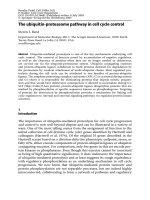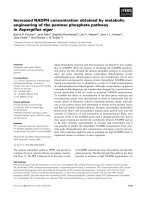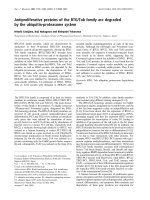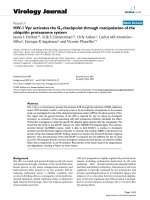Investigation of the role of the ubiquitin proteasome pathway in dengue virus life cycle 1
Bạn đang xem bản rút gọn của tài liệu. Xem và tải ngay bản đầy đủ của tài liệu tại đây (4.65 MB, 78 trang )
!
!
!
!
!
!
!
!
!
!
!
!
!
!
!
!
!
!
!
!
!
!
!
!
!
!
!
!
!
!
!
!
!
!
!
!
Copyright by
Choy Ming Ju Milly
2015
!
!
iv!
Abstract
The mosquito-borne dengue virus (DENV) is a cause of significant global health
burden. However, no licensed vaccine or specific antiviral treatment for dengue is
available. DENV interacts with host cell factors to complete its life cycle although
this virus-host interplay remains to be fully elucidated. Many studies have identified
the ubiquitin proteasome pathway (UPP) to be important for successful DENV
production, but how the UPP contributes to DENV life cycle as host factors remain ill
defined. We show here that a functional UPP is critical for virus egress in both Aedes
aegypti mosquitoes and human monocytic cell lines. Using RNA inference studies,
we show in vivo that knockdown of ubiquitin proteasome pathway-related genes,
including proteasomal subunits, ß1, ß2 and ß5 decouples RNA replication from
infectious titer production in the mosquito midgut. Mechanistically, inhibition of
proteasome function prevented virus egress by exacerbating endoplasmic reticulum
(ER) stress through the unfolded protein response (UPR). UPR-induced translational
repression reduced overall protein levels of the exocyst components needed for
exocytosis. This mechanism also appears to be amenable for clinical translation as
inhibition of UPP in primary monocytes with the licensed proteasome inhibitor,
bortezomib, inhibited DENV titers even at low nanomolar drug concentration.
Furthermore, we show in vivo in a wild type mouse model that DENV replication and
spread in the mouse spleen is exquisitely sensitive to proteasome inhibition. The
mechanism of action suggests that such a therapeutic approach may apply to other
viruses that rely on exocytosis for virus egress to complete their life cycle.
!
!
v!
Acknowledgements
I would like to express my heartfelt gratitude to Professor Duane J Gubler and
Associate Professor Ooi Eng Eong for their mentorship throughout the course of my
study. I thank them for being ever so generous in sharing their wealth of knowledge
and experiences with me.
My sincere appreciation is extended to my thesis advisory committee members,
Professor Subhash Vasudevan and Assistant Professor Ashley St John for their
invaluable advice and critical suggestions.
Special thanks to Summer Zhang, Tan Hwee Cheng, Mah Sook Yee, Angelia Chow,
Brett Ellis, Jason Tang, October Sessions and all my colleagues at Duke-NUS
Graduate Medical School for helping me in one way or another.
Lastly, I would like to acknowledge my loved ones, especially my mum and husband
for their encouragement all these years. My elder sister, Julieanne is also instrumental
in sparking my interest in science at a very young age. I am glad to be able to share
my successes and failures with them.
This body of work is dedicated to my little baby, Ethan, who is the main source of
my inspiration.
!
!
vi!
Contents
Title Page!! !i!
Abstract!Signature! !ii!
Copyright! !iii!
Abstract! !iv!
Acknowledgements! !v!
Table!of!Contents! !vi!
List of Tables! !x!
List of Figures! !xi!
Chapter 1. INTRODUCTION! !1!
1.1 Dengue 1
1.1.1 Dengue – a disease of global significance 1
1.1.2 Dengue structure and genome 5
1.1.3 Clinical symptoms and disease manifestations 9
1.1.4 Laboratory diagnosis of dengue 12
1.1.4.1 Immunoglobulin M (IgM) detection 12
1.1.4.2 Immunoglobulin G (IgG) detection 12
1.1.4.3 DENV isolation and propagation 12
1.1.4.4 Quantitative real time polymerase chain reaction (qRT-PCR) 14
1.1.4.5 NS1 antigen detection 15
1.2 Role of host and viral factors in dengue pathogenesis 17
1.2.1 Host factors 17
1.2.1.1 Epidemiological evidence for secondary infection and severe dengue 18
1.2.1.2 T cell response 18
1.2.1.3 Antibody-dependent enhancement (ADE) 19
1.2.2 Viral factors 23
!
!
vii!
1.2.2.1 Genotype differences 23
1.2.2.2 Glycosylation of E and NS1 proteins 24
1.2.2.3 Other viral factors 25
1.3 Animal models for dengue 26
1.3.1 Non-human primates 26
1.3.2 Laboratory mice 26
1.4 DENV infection in hosts 29
1.4.1 Life cycle of DENV 29
1.4.2 DENV infection in human 33
1.4.3 DENV infection in mosquito vector 33
1.5 Prevention and control of dengue 37
1.5.1 Ae. aegypti – a public health scourge 37
1.5.2 Vector control 37
1.5.3 Vaccine development and progress 40
1.5.3.1 Live attenuated vaccines and chimeric live attenuated vaccines 40
1.5.3.2 Bivalent or trivalent vaccines – a possibility? 42
1.5.4 Antiviral drugs 44
1.5.4.1 Therapeutic antibodies 44
1.5.4.2 Viral protein inhibitors 44
1.5.4.3 Antiviral therapies for supportive management of dengue 46
1.5.4.4 Host factors inhibitors 46
1.5.4.5 Celgosivir 47
1.6 Ubiquitin proteasome pathway in viral infection 50
1.7 Specific aims 53
Chapter 2. Materials and Methods 54
2.1 Mosquitoes and cells 54
2.2 Primary monocytes isolation 54
!
!
viii!
2.3 Virus stock 55
2.4 Plaque assay 55
2.5 qRT-PCR 56
2.6 DENV-2 infection in mosquitoes 56
2.7 Gene silencing assays 57
2.8 Generation of whole-transcriptome cDNA library 58
2.9 RNAseq analysis 58
2.10 DENV-2 infection in monocytes 59
2.11 DiD labeling of DENV-2 59
2.12 Alexa Fluor labeling of DENV-2 60
2.13 MTS cell viability assay 60
2.14 Western blots 61
2.15 Immunofluorescence 61
2.16 Transmission Electron Microscopy 62
2.17 RNase treatment of β–lactone treated cells 62
2.18 Annexin V staining of primary monocytes 62
2.19 Bortezomib treatment in DENV-infected C57BL/6 mice 63
2.20 Immunohistochemistry analysis of mouse spleen 63
2.21 Measurement of hematocrit level and platelet count in whole blood 64
2.22 MCPT-1, TNF-α and IFN-γ quantification 65
2.23 Viral load quantification in mouse spleen 65
2.24 Statistical analysis 66
Chapter 3. Results! !67!
3.1 Establish a mosquito infection model at Duke-NUS Graduate Medical School 67
3.1.1 Comparison of mosquito inoculation technique and qRT-PCR to measure
DENDENV concentration in mosquitoes, vertebrate and mosquito cell cultures, and h
a and human sera 67
3.2 Investigate the role of the UPP in DENV life cycle 77
!
!
ix!
3.2.1 Functional UPP is required for infectious DENV-2 production in mosquito
mmidguts 77
3.2.2 Regulation of UPP specific genes decouples infectious DENV-2 production
f from viral RNA replication in mosquito midguts 83
3.2.3 Proteasome inhibition with β-lactone did not alter virus entry at non-toxic
lelevels 91
3.2.4 DENV-2 egress is dependent on proteasome function 93
3.3 Proteasome inhibition exacerbates ER stress and represses translation of E
EXOC7,TC10 and EXOC1 98
3.4 Potential use of bortezomib, a proteasome inhibitor, as an anti-flaviviral drug 102
3.4.1 Bortezomib inhibits infectious DENV production in primary monocytes 102
3.4.2 Bortezomib reduced viral load and signs of dengue pathology in C57BL/6
mmice 108
3.5 Summary of results 112
Chapter 4. Discussion 113
4.1 Preface 113
4.2 Unfolded protein response during flavivirus infection 115
4.3 Repurposing proteasome inhibitors as an anti-flaviviral therapeutic 117
4.4 Learning from Ae. aegypti mosquito 121
4.5 Beyond the anti-viral effects of bortezomib: Potential use as an adjuvant 122
4.6 Conclusion 123
References 124
Appendix A 147
Appendix B 223
Biography 226
!
!
x!
List of Tables
Table 3.1: Comparative titration of C6/36 cell culture virus supernatants by qRT-PCR
and mosquito inoculation 73
Table 3.2: Percentage of DENV-2-infected mosquitoes after knockdown of
proteasome subunits (p-value; Fischer’s Exact test) 82
Table 3.3: Summary of Illumina HighSeq 2000 RNA-sequencing using Partek
Genomic Suite v6.6 85
Table 4.1: Current developments of proteasome inhibitors undergoing different
phases of clinical trials 120
!
!
!
xi!
List of Figures
!
Figure 1.1: Global distribution of dengue 3
Figure 1.2: Distribution of DENVs 1-4 in (A) 1970 and (B) 2011 4
Figure 1.3: Flavivirus genome and polyprotein 7
Figure 1.4: DENV structure 8
Figure 1.5: Clinical signs and symptoms of dengue 11
Figure 1.6: Viral load and antibodies quantification in primary dengue infection 16
Figure 1.7: ADE in dengue infection 22
Figure 1.8: DENV life cycle 31
Figure 1.9: Schematic representation of the exocyst complex tethering a vesicle to
plasma membrane 32
Figure 1.10: Anatomy of Ae. aegypti 36
Figure 1.11: Ae. aegypti distribution in the Americas during the 1930s and in 1970
and 2003 39
Figure 1.12: Dengue vaccines under development 43
Figure 1.13: Kaplan-Meier plots of viral NS1 antigen clearance 49
Figure 3.1: Replication kinetics of DENV-2 (A) PR1940 and (B) PR6913 in adult
female Ae. aegypti mosquitoes 70
Figure 3.2: Replication kinetics of DENV-2 derived in cell cultures measured by the
mosquito inoculation technique and qRT-PCR 71
Figure 3.3: Linear regression analysis between RNA copy number and MID
50
72
Figure 3.4: Comparative titration of ten viremic (DENV-2) human sera by qRT-PCR
and mosquito inoculation technique 76
Figure 3.5: Characterization of DENV-2 replication in the midguts and head/thoraces
of Ae. aegypti following ingestion of an infectious blood meal 80
Figure 3.6: Proteasome inhibition decouples infectious DENV-2 production from
viral RNA replication in mosquito midguts 81
Figure 3.7: RNA-sequencing of Ae. aegypti midgut 84
Figure 3.8: Differential regulation of genes belonging to UPP during DENV infection 88
!
!
xii!
Figure 3.9: Functional UPP is required for infectious DENV-2 production in mosquito
midgut 89
Figure 3.10: Functional UPP is required for infectious DENV-2 production in
mosquito head/thorax 90
Figure 3.11: Proteasome inhibition with β-lactone did not alter virus entry at non-
toxic levels 92
Figure 3.12: β-lactone decouples infectious DENV-2 production from viral RNA
replication in THP-1 cells 94
Figure 3.13: DENV-2 egress is dependent on proteasome function 96
Figure 3.14: Increased amount of packaged DENV observed after proteasome
inhibition 97
Figure 3.15: Protein levels of EXOC7, TC10 and EXOC1 decreased post β-lactone
treatment, but transcript levels remained unchanged 99
Figure 3.16: UPP inhibition increases ER stress and attenuates translation of EXOC7
and TC10 101
Figure 3.17: Bortezomib decouples infectious DENV production from viral RNA
replication in primary monocytes 104
Figure 3.18: Bortezomib inhibits infectious virus production for different strains of all
4 dengue serotypes and YF17D in a dose-dependent manner in primary monocytes 105
Figure 3.19: Epoxomicin reduces infectious DENV titers in a dose-dependent manner
for all 4 dengue serotypes 106
Figure 3.20: Bortezomib induces apoptosis in primary monocytes at 6 hpi 107
Figure 3.21: Bortezomib inhibited DENV spread in spleen of WT mice 109
Figure 3.22: Bortezomib alleviated signs of dengue in C57BL/6 mice 110
Figure 3.23: Bortezomib alleviated inflammatory responses in DENV infected
C57BL/6 mice 111
Figure 4.1: Schematic diagram of findings 114
!
!
!
!
!
!
!
!
1!
Chapter 1: Introduction
1.1 Dengue
1.1.1 Dengue – a disease of global significance
Dengue has emerged to be the most important arthropod-borne viral disease globally,
causing an estimated 390 million infections annually (Bhatt et al, 2013). The global
prevalence of dengue has increased dramatically in the past 40 years and is now
endemic in more than 100 countries in Africa, South-east Asia, the Americas, the
Eastern Mediterranean, and the Western Pacific (Gubler, 2014). Consequently, 3
billion people that live in or travel to the tropics are at constant risk of infection with
any of the four DENV serotypes (DENV-1, DENV-2, DENV-3 and DENV-4) (Bhatt
et al, 2013) (Figure 1-1).
Infection with any of the four serotypes of DENV may result in a spectrum of illness,
ranging from subclinical to undifferentiated febrile illness, to classical dengue fever
(DF), and in more severe cases, to dengue hemorrhagic fever (DHF)/dengue shock
syndrome (DSS) (Trung & Wills, 2014). DHF/DSS is an acute and sometimes deadly
illness characterized by thrombocytopenia, bleeding tendency and capillary leakage
that if left untreated, could lead to hypovolemic shock. Fatality rates can be as high as
20% without appropriate medical support (WHO, 2009). In addition to human
suffering, dengue results in substantial economic impact (Shepard et al, 2014).
Despite under-reporting of cases in many dengue endemic regions, it is estimated that
over the next decade, dengue will collectively cost South-East Asian nations US$2.36
billion in lost productivity and medical care (Shepard et al, 2014).
!
!
2!
The lack of effective mosquito control, environmental changes associated with rapid
population growth, unplanned urbanization and increased international air travel have
collectively contributed to the geographic spread of Aedes aegypti (Ae. aegypti) and
the dispersal of DENVs (Gubler, 2002; Gubler, 2004; Gubler & Meltzer, 1999;
Rigau-Perez et al, 1998) (Figure 1-2). To further exacerbate the problem, there is no
licensed vaccine or specific antiviral treatment for dengue. The high prevalence of
dengue, together with the absence of specific therapeutics and lack of effective
preventive measures conspire to make dengue an even more acute global public
health threat (Kyle & Harris, 2008).
!
!
3!
Figure 1-1 Global distribution of dengue. An estimated 390 million dengue
infections occur worldwide annually.
Dengue is now endemic in more than 100
countries in Africa, South-east Asia, the Americas, the Eastern Mediterranean, and
the Western Pacific. Figure adapted from (Bhatt et al, 2013).
!
!
4!
DEN 1
DEN 2
DEN 1
DEN 2
DEN 3
DEN 4
DEN 1
DEN 2
Figure 1-2. Distribution of DENVs 1-4 in (A) 1970 and (B) 2011. Compared to
the 1970s, the increased incidence and spread of all four dengue serotypes
observed in 2011 indicates the urgent need for DENV control. Figure adapted from
(Gubler, 1998)
DEN 1
DEN 2
DEN 3
DEN 4
DEN 1
DEN 2
DEN 3
DEN 4
DEN 1
DEN 2
DEN 3
DEN 4
DEN 1
DEN 2
DEN 3
DEN 1
DEN 2
DEN 3
DEN 4
DEN 1
DEN 2
DEN 3
DEN 4
DEN 1
DEN 2
DEN 3
DEN 4
DEN 1
DEN 2
DEN 3
DEN 4
A
B
DEN 1
DEN 2
DEN 3
DEN 4
!
!
5!
1.1.2 Dengue structure and genome
Dengue belongs to the genus Flavivirus family Flaviviridae (Kuno et al, 1998;
Solomon & Mallewa, 2001). The Flaviviridae family includes several other viruses
that pose a threat to public health, such as the yellow fever virus, Japanese
encephalitis virus, West Nile virus and tick-borne encephalitis virus (Gould &
Solomon, 2008).
Flaviviruses are enveloped RNA viruses 45-50 nm in diameter that contain a single-
strand, positive-sense capped RNA genome of approximately 11 kb. The four DENV
serotypes are immunologically distinct but antigenically related, each sharing about
65-70% homology. The genome is made up of three structural and seven non-
structural proteins (Chambers et al, 1990), which is translated as a large precursor
polypeptide molecule from a single, long open reading frame. The unique open
reading frame is flanked by two untranslated regions (UTRs), which contain structural
and functional elements required for viral translation and replication. The N-terminal
region encodes the structural proteins, capsid (C), pre-membrane (prM) and envelope
(E), followed by the nonstructural proteins NS1, NS2A, NS2B, NS3, NS4A, NS4B
and NS5. Individual mature viral proteins are then processed from the polyprotein by
both cellular and viral proteases (Harris et al, 2006; Westaway, 1987) (Figure 1-3).
The glycoprotein E contains most of the antigenic determinants of the virus and is
essential for viral attachment and entry, while M, synthesized as the precursor (prM),
functions as a chaperone during maturation of the viral particle. The E protein can be
divided into three structural or functional domains: the central domain; the
!
!
6!
dimerization domain, which presents a fusion peptide; and the receptor-binding
domain (Figure 1-4). The highly basic C protein packages the RNA genome and is
surrounded by 180 monomers of E protein that are organized into tightly packed
dimers and lies flat on the surface of the viral membrane (Rey, 2003). The other seven
non-structural proteins (NS1, NS2A, NS2B, NS3, NS4A, NS4B and NS5) are
essential for viral RNA replication, assembly and modulation of host cell responses
(Pastorino et al, 2010).
!
!
7!
Figure 1-3 Flavivirus genome and polyprotein. The 11 kb flavivirus genome is
made up of three structural and seven non-structural proteins, which is translated as
a large precursor polypeptide molecule from a single, long open reading frame. The
unique open reading frame is flanked by two UTRs. The N-terminal region encodes
the structural proteins, C, prM and E, followed by the nonstructural proteins NS1,
NS2A, NS2B, NS3, NS4A, NS4B and NS5. Individual mature viral proteins are then
processed from the polyprotein by both cellular and viral proteases. Figure adapted
from (Pastorino et al, 2010).
!
!
8!
Figure 1-4 DENV structure. DENV is a spherical and enveloped virus 50 nm in
diameter. The virion contains three structural proteins C, M and E and the RNA
genome. The surface of the mature DENV virion is smooth with the envelope
proteins aligned in pairs parallel to the virion surface. The E protein can be divided
into three structural or functional domains: the central domain; the dimerization
domain, which presents a fusion peptide; and the receptor-binding domain. Figure
adapted from (Kuhn et al, 2002).
!
!
9!
1.1.3 Clinical symptoms and disease manifestations
Infection with any one of the four serotypes of DENV may cause a wide spectrum of
clinical outcome. The incubation period can range from 3-14 days before symptoms
develop. Characteristic symptoms of classical DF include high fever accompanied by
2 or more symptoms of headache, retro-orbital pain, myalgia, arthralgia, flushing of
the face, rash, anorexia, nausea and abdominal pain. During fever defervescence,
macular rash may be observed and most patients recover without complications about
a week after disease onset (WHO, 2009). However, a small percentage of patients
may progress to severe disease during this period of fever defervescence.
The most common form of severe disease, DHF is characterized by a fever lasting 2-7
days, a tendency to bleed, thrombocytopenia (platelet count ≤ 100,000/mm
3
), and
plasma leakage. When a critical volume of plasma is lost through leakage, cardiac
output may become insufficient to maintain the necessary blood pressure resulting in
DSS. With prolonged shock, organ hypofusion can result in progressive organ
impairment, metabolic acidosis and disseminated intravascular coagulation (WHO,
1997), eventually resulting in death within 12 to 36 hours after shock onset (Figure 1-
5). Currently, treatment of acute dengue is supportive, using either oral or intravenous
rehydration for mild or moderate disease, and intravenous fluids and blood
transfusion for more severe cases. With early diagnosis and proper management,
fatality rates can be decreased to 1% or less (Kalayanarooj, 2014; Trung & Wills,
2014; WHO, 1997).
Many dengue infections present as viral syndrome and may be missed or mistaken for
!
!
10!
influenza or another viral infection. A definitive diagnosis of dengue infection can be
made only in the laboratory and relies on detecting specific antibodies in the patient’s
serum, isolating the virus, or detecting viral antigen or RNA in serum or tissues.
!
!
11!
Figure 1-5 Clinical signs and symptoms of dengue. WHO case definition of (A)
DF, (B) DHF, and (C) DSS. (D) The incubation period before signs of symptoms
develop can range from day 3 to day 14, average 4-7. Figure adapted from
(Whitehead et al, 2007).
!
!
12!
1.1.4 Laboratory diagnosis of dengue
1.1.4.1 Immunoglobulin M (IgM) detection
The efficacy of clinical diagnosis, surveillance, prevention and control of dengue has
been limited by the lack of low-cost, easy to use and sensitive diagnostic tests.
Currently, laboratory diagnosis in most dengue endemic countries relies on detecting
immunoglobulin M (IgM) antibody in acute serum samples. IgM antibodies can be
detected as early as 4 days after the onset of fever. IgM peaks at approximately two
weeks following fever onset and then decline to undetectable levels over the next two
months (Guzman et al, 2010) (Figure 1-6). IgM antibody capture ELISA (MAC-
ELISA) is based on capturing human IgM antibodies on a microtiter plate using anti-
human-IgM antibody, followed by the addition of DENV specific antigen containing
viral E protein. One limitation of this assay is that serologic diagnosis of dengue may
be confounded if the patient had recently been infected or vaccinated with an
antigenically related flavivirus due to the cross-reactive nature of the antibody.
1.1.4.2 Immunoglobulin G (IgG) detection
During primary infection, immunoglobulin G (IgG) can be detected 7- 10 days after
illness onset, making it less useful for early diagnosis (Figure 1-6). However, the
rapid increase of IgG levels during secondary infection (as early as day 4 from illness
onset) can be suggestive of dengue when the ratio of IgM and IgG is used.
1.1.4.3 DENV isolation and propagation
!
!
13!
Besides serological tests, isolation of virus from patient samples during the febrile
phase is routinely performed in the laboratory as a diagnostic test. The added
advantage is the availability of viral isolates, which is essential for characterizing
virus strain differences, critical for viral surveillance and pathogenesis studies.
DENV has been among the most difficult viruses to isolate and propagate because the
virus does not infect or replicate well in most laboratory animals and mammalian cell
cultures. Studies on dengue in the 1940s to 1960s used suckling mice and various
tissue culture systems for isolation and assay of DENV (Halstead et al, 1964;
Hammon et al, 1960; Igarashi, 1978; Sukhavachana et al, 1966; Yuill et al, 1968).
Although the use of mammalian and insect cell culture systems improved sensitivity
(Igarashi, 1978; Sukhavachana et al, 1966; Yuill et al, 1968), which is influenced by
both the cell culture system and the strain of DENV, many unpassaged DENV do not
produce cytopathic effects (CPE) when grown in these cells. The lack of a sensitive
isolation and assay system that could be used for unpassaged wild type viruses,
prevented rapid advancement in dengue research.
In large urban centers of the tropics, DENVs are usually maintained naturally in an
Ae. aegypti-human-Ae. aegypti cycle with periodic epidemics (Gubler, 1988). The
development of the mosquito inoculation technique in the early 1970s provided a
highly sensitive method for the isolation, propagation and quantitation of DENV
(Rosen & Gubler, 1974). The use of a natural host proved to be 10 to 1000 times more
sensitive in detecting dengue viruses than the commonly used plaque assay,
depending on the serotype or strain of virus (Choy et al, 2013). As DENV can be
frequently recovered from serum in mosquitoes when the same serum tested negative









